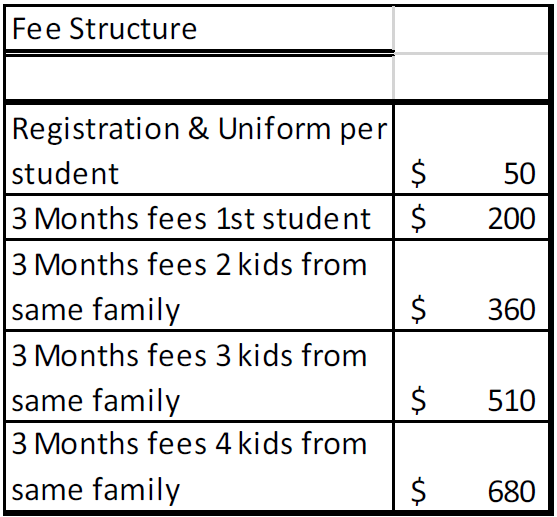SHOTOKAN KARATE-DO
” The ultimate aim of the art of Karate lies not in victory or defeat, but in the perfection of character of its participants.”
Gichin Funakoshi Founder of Shotokan Karate


PROGRAM DETAIL & BENEFITS OF SHOTOKAN KARATE
Regular Session Starting at MCMC
Tue: 7:00 – 8:00 PM & Wed: 7:00 – 8:00 PM
Location: Gymnasium
For more detail call with any questions :
Sensei Javed Khan 732.322.7672 (cell)
Download Rule of Conduct and Fee Structure
BENEFITS OF SHOTOKAN KARATE:
Builds self-esteem
Enhances flexibility
Improves coordination & balance
Maximizes cardio-respiratory fitness
Promotes discipline
Teaches self defense

About the Instructor: Sensei Javed Khan
Sensei Javed Khan is a 3rd degree black belt and has been studying the art of Shotokan karate for the past 30yrs. He was 12yrs old when he started training and ever since then has been an avid karateka. He has trained under numerous instructors from Japan to name a few it includes Sensei Soichi Sasaki, Sensei Tanaka. Sensei Javed Khan hails from Mumbai India and his teacher from India is Sensei Anil Garodia (6 dan Black Belt). Currently is affiliated to AJKAI and trains under Sensei Rob DeAngelis (7 dan black belt). The home dojo of East coast AJKAI is located in Solesbury, PA.
Sensei Javed Khan migrated to the United states in 1999, ever since then he has been teaching the community kids of the ISCJ (Islamic Society of Central Jersey). He has had over 20 black belts graduate under his guidance and teaching, of which two has been girls one of which is currently pursuing her Nee Dan (2nd Degree black belt). In 2016 Sensei Javed has been invited by the ICMC (Islamic community of Mercer County) and Masjid Al-Minhal in Edison, to come and teach the kids in their respective communities.
About ShotoKan Karate-Do
Karate means “empty (Kara) hand(tae)”, and Karate-do translates to “the way of Karate”. Shotokan Karate is a weaponless martial art that is founded on the basic techniques of punching, striking, kicking and blocking, yet there is a deeper aspect to serious Karate training which deals with character development. Shotokan Karate is a way for an individual to realize greater potential and expand the limits of that individual’s physical and mental capabilities. Karate in an excellent, time-proven method of personal development. Shotokan Karate is a traditional Japanese Martial Art founded by Master Gichin Funakoshi. Shotokan Karate remains firmly rooted in a strong martial arts tradition, emphasizing lifetime training for a healthy mind and body, rather than strictly as a sport.
Shotokan is a style of karate, developed from various martial arts by Gichin Funakoshi (1868–1957) and his son Gigo (Yoshitaka) Funakoshi (1906–1945). Gichin was born in Okinawa and is widely credited with popularizing “karate do” through a series of public demonstrations, and by promoting the development of university karate clubs, including those at Keio, Waseda, Hitotsubashi (Shodai), Takushoku, Chuo, Gakushuin, and Hosei.
Funakoshi had many students at the university clubs and outside dojos, who continued to teach karate after his death in 1957. However, internal disagreements (in particular the notion that competition is contrary to the essence of karate) led to the creation of different organizations—including an initial split between the Japan Karate Association (headed by Masatoshi Nakayama) and the Shotokai (headed by Motonobu Hironishi and Shigeru Egami), followed by many others—so that today there is no single “Shotokan school”, although they all bear Funakoshi’s influence.
As the most widely practiced style, Shotokan is considered a traditional and influential form of karate do.
Shotokan was the name of the first official dojo built by Gichin Funakoshi, Shoto, meaning “pine-waves” (the movement of pine needles when the wind blows through them), was Funakoshi’s pen-name, which he used in his poetic and philosophical writings and messages to his students. The Japanese kan means “house” or “hall”. In honor of their sensei, Funakoshi’s students created a sign reading shoto-kan, which they placed above the entrance of the hall where Funakoshi taught. Gichin Funakoshi never gave his system a name, just calling it karate.
Shotokan training is usually divided into three parts: kihon (basics), kata (forms or patterns of moves), and kumite (sparring). Techniques in kihon and kata are characterized by deep, long stances that provide stability, enable powerful movements, and strengthen the legs. Shotokan is regarded as a dynamic martial art as it develops anaerobic, powerful techniques as well as developing speed. Initially strength and power are demonstrated instead of slower, more flowing motions. Those who progress to brown and black belt level develop a much more fluid style that incorporates grappling, throwing and some standing joint locking jiu-jitsu-like techniques, which can be found even in basic kata. Kumite (fighting) techniques are practiced in the kihon and kata and developed from basic to advanced levels with an opponent.
You! Even if you feel you are overweight, uncoordinated, inflexible, or lacking self-confidence or self-discipline, you may have the most to gain by training. Of course results should not be expected overnight, but if you train on a regular basis and stay with it, you will begin to see improvement. Nothing of real value is ever obtained with ease. All kinds of people benefit from Karate training. Men, women and children can be found at our dojo.
This means “ethics of the dojo”. The dojo is training center for Shotokan Karate.
Character
Sincerity
Effort
Self-Control
Courtesy

